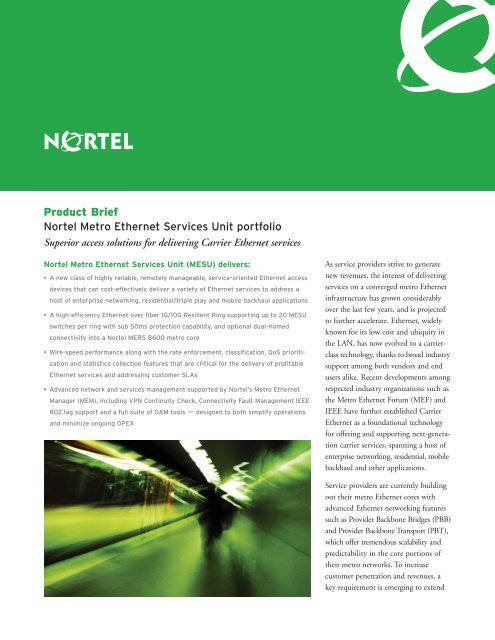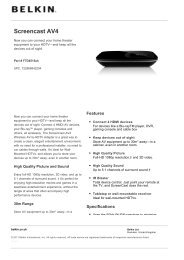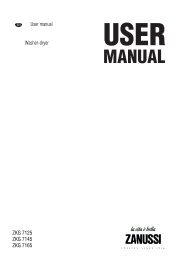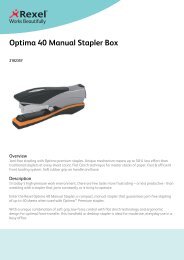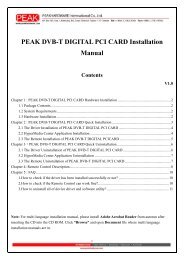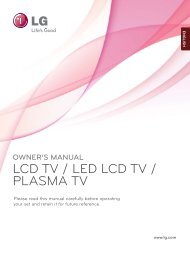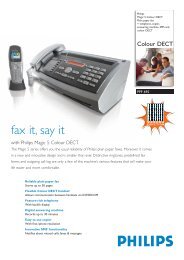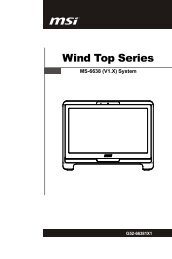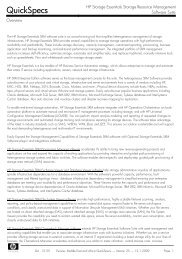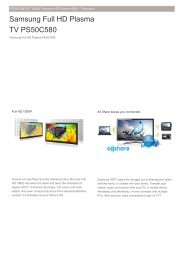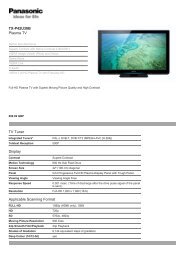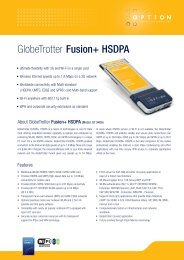Nortel Metro Ethernet Services Unit portfolio
Nortel Metro Ethernet Services Unit portfolio
Nortel Metro Ethernet Services Unit portfolio
You also want an ePaper? Increase the reach of your titles
YUMPU automatically turns print PDFs into web optimized ePapers that Google loves.
Product Brief<br />
<strong>Nortel</strong> <strong>Metro</strong> <strong>Ethernet</strong> <strong>Services</strong> <strong>Unit</strong> <strong>portfolio</strong><br />
Superior access solutions for delivering Carrier <strong>Ethernet</strong> services<br />
<strong>Nortel</strong> <strong>Metro</strong> <strong>Ethernet</strong> <strong>Services</strong> <strong>Unit</strong> (MESU) delivers:<br />
• A new class of highly reliable, remotely manageable, service-oriented <strong>Ethernet</strong> access<br />
devices that can cost-effectively deliver a variety of <strong>Ethernet</strong> services to address a<br />
host of enterprise networking, residential/triple play and mobile backhaul applications<br />
• A high-efficiency <strong>Ethernet</strong> over fiber 1G/10G Resilient Ring supporting up to 20 MESU<br />
switches per ring with sub 50ms protection capability, and optional dual–homed<br />
connectivity into a <strong>Nortel</strong> MERS 8600 metro core<br />
• Wire-speed performance along with the rate enforcement, classification, QoS prioritization<br />
and statistics collection features that are critical for the delivery of profitable<br />
<strong>Ethernet</strong> services and addressing customer SLAs<br />
• Advanced network and services management supported by <strong>Nortel</strong>’s <strong>Metro</strong> <strong>Ethernet</strong><br />
Manager (MEM), including VPN Continuity Check, Connectivity Fault Management IEEE<br />
802.1ag support and a full suite of OAM tools — designed to both simplify operations<br />
and minimize ongoing OPEX<br />
As service providers strive to generate<br />
new revenues, the interest of delivering<br />
services on a converged metro <strong>Ethernet</strong><br />
infrastructure has grown considerably<br />
over the last few years, and is projected<br />
to further accelerate. <strong>Ethernet</strong>, widely<br />
known for its low cost and ubiquity in<br />
the LAN, has now evolved to a carrierclass<br />
technology, thanks to broad industry<br />
support among both vendors and end<br />
users alike. Recent developments among<br />
respected industry organizations such as<br />
the <strong>Metro</strong> <strong>Ethernet</strong> Forum (MEF) and<br />
IEEE have further established Carrier<br />
<strong>Ethernet</strong> as a foundational technology<br />
for offering and supporting next-generation<br />
carrier services, spanning a host of<br />
enterprise networking, residential, mobile<br />
backhaul and other applications.<br />
Service providers are currently building<br />
out their metro <strong>Ethernet</strong> cores with<br />
advanced <strong>Ethernet</strong> networking features<br />
such as Provider Backbone Bridges (PBB)<br />
and Provider Backbone Transport (PBT),<br />
which offer tremendous scalability and<br />
predictability in the core portions of<br />
their metro networks. To increase<br />
customer penetration and revenues, a<br />
key requirement is emerging to extend
the reach of Carrier <strong>Ethernet</strong> services<br />
further out from the core and closer to<br />
customer access locations. This has<br />
driven the need for a new class of<br />
highly-reliable, remotely manageable,<br />
service-oriented <strong>Ethernet</strong> access devices<br />
to cost-effectively aggregate <strong>Ethernet</strong><br />
services into this robust metro core. The<br />
<strong>Nortel</strong> family of <strong>Metro</strong> <strong>Ethernet</strong> <strong>Services</strong><br />
<strong>Unit</strong>s (MESUs) offers a wide range of<br />
options for <strong>Ethernet</strong> services aggregation<br />
to address this need. The <strong>Metro</strong> <strong>Ethernet</strong><br />
<strong>Services</strong> <strong>Unit</strong> family enables providers to<br />
offer high-bandwidth IP/<strong>Ethernet</strong> services<br />
with granular service assurance and<br />
superior operational simplicity to minimize<br />
ongoing OPEX. MESU delivers<br />
wire-speed performance along with the<br />
rate enforcement, classification, QoS/<br />
prioritization and statistics collection<br />
features that are critical for the delivery of<br />
profitable <strong>Ethernet</strong> services, while<br />
addressing the SLAs required by end<br />
customers for all manner of services.<br />
Multiple deployment<br />
options and access<br />
resilience<br />
The <strong>Nortel</strong> family of <strong>Metro</strong> <strong>Ethernet</strong><br />
<strong>Services</strong> <strong>Unit</strong> (MESU) platforms can<br />
support a variety of deployment models<br />
to suit applications for various access<br />
topologies (see Figure 1). The four modes<br />
of operation are: Layer 2 Switching,<br />
VLAN (QinQ) encapsulation, MESU<br />
Resilient Ring and stand-alone. In Layer 2<br />
switch mode, the MESU functions as a<br />
standards-based, high-bandwidth access<br />
switch that provides Layer 2 operational<br />
services such as Layer 2 VLANs, IGMP,<br />
Spanning Tree and MLT. In VLAN<br />
Encapsulation mode, the ESU offers<br />
standards-based IEEE 802.1ad (QinQ)<br />
VLAN stacking to provide secure access<br />
to the network using the outer Q-tag<br />
for identifying and separating customer<br />
traffic onto separate VLANs.<br />
Figure 1. <strong>Metro</strong> <strong>Ethernet</strong> <strong>Services</strong> <strong>Unit</strong> deployment options<br />
2<br />
Residential<br />
Backhaul<br />
Mobile<br />
Backhaul<br />
DSLAM/CMTS<br />
EoBx<br />
EoSFP<br />
EoVDSL<br />
Stand-alone<br />
or QinQ mode<br />
access<br />
Layer 2<br />
switch mode<br />
Up to 20<br />
MESUs/Ring<br />
10/100/1000<br />
<strong>Ethernet</strong><br />
access<br />
Outside Cabinet<br />
Multi-Link<br />
Trunk access<br />
<strong>Metro</strong> <strong>Ethernet</strong> Routing<br />
Switch 8600<br />
Carrier <strong>Ethernet</strong><br />
<strong>Metro</strong> Core<br />
(PBB/PBT)<br />
Dual-homed<br />
access<br />
1GE/10GE<br />
Resilient<br />
Rings<br />
The MESU Resilient Ring mode offers<br />
industry-leading reliability with high<br />
efficiency aggregation using an <strong>Ethernet</strong>over-fiber<br />
solution. It allows for up to<br />
20 ESUs to be connected on a fiber ring<br />
supporting sub 50ms protection capability,<br />
when homed to a <strong>Metro</strong> <strong>Ethernet</strong><br />
Routing Switch (MERS) 8600, or a pair<br />
of MERS 8600s in a dual-homed<br />
configuration. MESU rings are available<br />
in GE configurations today with support<br />
for 10GE planned in the near future.<br />
Another advantage of the resilient ring<br />
architecture is the ability to optimize<br />
unused bandwidth when aggregating<br />
traffic into the metro core. Enterprise<br />
customers are demanding flexible service<br />
rates, typically at intervals lower than<br />
the full rate of the interface (e.g., 25 Mbps<br />
on a 100-Mbps port). If the access<br />
infrastructure is constructed in a pointto-point<br />
fashion, there is a greater likelihood<br />
that the <strong>Ethernet</strong> uplink from the<br />
Enterprise<br />
Access<br />
Core<br />
networks<br />
<strong>Metro</strong> <strong>Ethernet</strong> Service <strong>Unit</strong>s<br />
1800/1850/1860/1880
CLE device to the central office device<br />
will be severely under-utilized. The<br />
<strong>Ethernet</strong> access ring capability enabled<br />
by the MESU series and the MERS<br />
8600 provides an <strong>Ethernet</strong> aggregation<br />
network that efficiently utilizes the<br />
access ports for optimized infrastructure<br />
investment.<br />
The MESU <strong>portfolio</strong> supports an<br />
enhanced bi-directional dual-homed<br />
ring capability that further improves<br />
access resiliency and reduces single points<br />
of failure. In a dual-homed configuration,<br />
MESUs can be configured on a Resilient<br />
Ring that begins on one MERS 8600<br />
and terminates on another MERS 8600,<br />
which could even be located in another<br />
physical location. This adds another<br />
level of resilience by providing equipment<br />
protection at the ring ‘headend’.<br />
In addition, since traffic can flow in<br />
either direction around the ring, this<br />
also improves the scalability and operational<br />
ease of managing dual-homed<br />
rings. Dual-homed rings are being<br />
introduced in the latest software release<br />
for MESU 1800/1850/1860 platforms,<br />
and are planned for the MESU 1880 in<br />
a subsequent release.<br />
Options are also available for providers<br />
with sites that cannot be supported on a<br />
resilient ring topology but would still<br />
like to have access resilience. For example,<br />
dual-homed uplinks to a pair of MERS<br />
8600s can be supported in a Layer 2<br />
switched or VLAN (QinQ) encapsulation<br />
mode from the MESU 1860/1880<br />
platforms.<br />
Multiple classes of service<br />
and QoS support<br />
Service providers today seek top-line<br />
growth and must maximize revenue<br />
generation. The ability to deliver multiple<br />
services to each customer while leveraging<br />
the same infrastructure helps do<br />
just that. The MESU family allows<br />
Table 1. <strong>Metro</strong> <strong>Ethernet</strong> <strong>Services</strong> <strong>Unit</strong> features and benefits<br />
Feature Benefits<br />
<strong>Ethernet</strong> Access<br />
Ring Resiliency<br />
IEEE 802.1Q/p and<br />
IETF DiffServ<br />
VPN Continuity Check<br />
Packet classification<br />
Granular rate<br />
enforcement<br />
Network management<br />
RMON<br />
IGMP v1/v2<br />
service providers to deliver more than<br />
just <strong>Ethernet</strong> connectivity service, e.g.,<br />
ELINE/ELAN over the <strong>Metro</strong> <strong>Ethernet</strong><br />
infrastructure. It enables providers to<br />
offer value-added services that enterprise<br />
customers are demanding. End customers<br />
can maintain the VLAN schemes used<br />
in their own networks, yet still access<br />
different services offered by the service<br />
provider — all enabled by the same<br />
<strong>Ethernet</strong> interface of the <strong>Metro</strong> <strong>Ethernet</strong><br />
<strong>Services</strong> <strong>Unit</strong>. Simply put, service<br />
providers are able to leverage a lower-<br />
Enables ring-based deployment of <strong>Metro</strong> <strong>Ethernet</strong> <strong>Services</strong> <strong>Unit</strong>,<br />
achieving 50ms recovery in an <strong>Ethernet</strong>-over-fiber implementation;<br />
supports up to 20 nodes per access ring for efficient access<br />
aggregration and optional dual-homing into a MERS 8600 core.<br />
Enables the service provider to offer multiple classes of services,<br />
e.g. gold, silver and best effort, etc. and tiered services with<br />
appropriate prioritization.<br />
Couples with MERS 8600 to provide tools for performance monitoring,<br />
service assurance, SLA measurement and troubleshooting.<br />
Flexible classification based on: port, port + VLAN, port + VLAN +<br />
802.1p bit, port + DSCP, and port + 802.1p combinations. Also<br />
support filtering based on source/destination IP address, TCP/UDP<br />
source/destination port and destination MAC address.<br />
Supports rate enforcement of Customer Information Rates (CIRs)<br />
and burst window sizes, where packets can be policed in user<br />
configurable 1-Mbps increments from 1 Mbps to line rate. Policing<br />
parameters can be set on various combinations, including: per port,<br />
per port per VLAN, per port per VLAN per 802.1p bit, per port per<br />
DSCP, and per port per 802.1p basis.<br />
Command Line Interface, RADIUS authentication and accounting,<br />
SNMPv1/v2 and management applications including: Java Device<br />
Manager, Product Service Provisioning, <strong>Metro</strong> <strong>Ethernet</strong> Management<br />
(MEM) system provide ease of management and flexibility to adapt<br />
to multiple operational environments and provide comprehensive<br />
<strong>Ethernet</strong> service provisioning, fault management and performance<br />
monitoring capabilities, including IEEE 802.1ag support.<br />
Supports four groups of RMON including Statistics, History, Alarms,<br />
Events from remote monitoring and operational simplicity.<br />
IP multicast support by examining (snooping) all IGMP traffic in<br />
hardware at line rate and pruning unwanted data stream from<br />
affecting network or end-station performance<br />
cost, shared network infrastructure<br />
across multiple customers and offer<br />
consistent services and SLAs.<br />
The MESU family supports packet classification<br />
based on IEEE 802.1Q/p<br />
and DiffServ Code Points which allows<br />
service providers to offer tiered services<br />
with QoS to end customers profitably.<br />
For example, the ability to classify traffic<br />
as early as possible helps ensure that<br />
mission-critical applications, such as<br />
VoIP and video, are given the level of<br />
3
performance dictated by their service<br />
contracts on an end-to-end basis. By<br />
assigning different service class levels to<br />
traffic flows, applications can be given<br />
the bandwidth and network priority<br />
required when and where they need it.<br />
The MESU provides the performance<br />
and QoS features to support the<br />
requirements of delay-sensitive applications.<br />
Four priority egress queues form<br />
the basis of MESU 1800 traffic management<br />
functionality, while the MESU<br />
1850/1860/1880 supports eight egress<br />
queues. With the ability to classify<br />
traffic based on IEEE 802.1Q/p and<br />
DiffServ markings and prioritize them<br />
accordingly, delay-sensitive applications<br />
can be given priority across the access.<br />
With the MESU’s support of multiple<br />
classes of services and QoS prioritization,<br />
providers are able to ensure consistent<br />
QoS to meet their customers’ SLA<br />
requirements.<br />
Network and service<br />
management<br />
The <strong>Metro</strong> <strong>Ethernet</strong> <strong>Services</strong> <strong>Unit</strong>s<br />
(MESUs) are designed for ease of use to<br />
simplify overall network operations and<br />
minimize the service provider’s ongoing<br />
OPEX. MESUs can be configured<br />
quickly with minimal manual intervention,<br />
decreasing implementation times<br />
and reducing the risk of errors. The<br />
MESU is fully manageable, both in or<br />
out of band, with SNMP applications,<br />
including <strong>Nortel</strong>’s advanced <strong>Metro</strong><br />
<strong>Ethernet</strong> Manager (MEM).<br />
MEM provides both network element<br />
and service management for the MESU<br />
<strong>portfolio</strong>, MERS 8600 and other <strong>Nortel</strong><br />
<strong>Metro</strong> <strong>Ethernet</strong> platforms. MEM<br />
provides capabilities ranging from<br />
central device management for software<br />
distribution to end-to-end service provisioning<br />
across the metro network, and<br />
the delivery of network fault, inventory<br />
and provisioning information via stan-<br />
4<br />
dard northbound interfaces to higherlevel<br />
OSS systems. With MEM, <strong>Nortel</strong><br />
is leveraging the expertise and knowledge<br />
gained with circuit-based network<br />
operations to deliver a consistent operational<br />
model across Layer 0, Layer 1 and<br />
Layer 2.<br />
<strong>Nortel</strong> also provides high-value management<br />
applications that offer comprehensive<br />
and deterministic services<br />
management. With the network and<br />
service viewer feature, providers have a<br />
proactive service assurance solution with<br />
<strong>Ethernet</strong> OAM instrumentation and<br />
advanced multi-layer troubleshooting.<br />
This provides deterministic customer<br />
and/or service impact assessment, with<br />
fault isolation and full troubleshooting<br />
capabilities across both <strong>Ethernet</strong> and<br />
optical-based domains. MESU provides<br />
support for IEEE 802.1ag — a key<br />
<strong>Ethernet</strong> OAM standard for Layer 2<br />
connectivity and fault management that<br />
provides valuable tools for verifying the<br />
availability of end-to-end <strong>Ethernet</strong> services.<br />
This MESU-supported capability is<br />
highly beneficial to service providers<br />
offering <strong>Ethernet</strong> access services, by<br />
allowing them to perform remote diagnostics<br />
on devices deployed as CLE or<br />
in outside plant locations, minimizing<br />
the need for costly truck rolls.<br />
Another key differentiator is <strong>Nortel</strong>’s<br />
<strong>Ethernet</strong> VPN management solution:<br />
VPN Continuity Check — a powerful<br />
service assurance and debugging tool<br />
critical for measuring and validating<br />
customers’ SLAs. It may be used to validate<br />
all VPN end-points, test connectivity<br />
and determine roundtrip delay<br />
measurements per VPN. This information<br />
is used by network management to<br />
verify that SLA parameters are being<br />
achieved and to generate a trend of the<br />
service report over time. This tool allows<br />
service providers to detect problems<br />
before customers notice any service<br />
degradation, isolating problems quickly<br />
and methodically. By verifying not only<br />
the integrity of the path all the way to<br />
the customer-facing port, but the total<br />
delay incurred, this capability allows for<br />
true end-to-end SLA verification.<br />
Multiple platform options<br />
to choose from<br />
<strong>Nortel</strong> offers a broad <strong>portfolio</strong> of <strong>Metro</strong><br />
<strong>Ethernet</strong> <strong>Services</strong> <strong>Unit</strong> (MESU) platform<br />
options to address the diverse<br />
application and deployment needs of<br />
<strong>Ethernet</strong> service providers. These platform<br />
options provide <strong>Ethernet</strong> connectivity<br />
ranging from 10 Mbps to 10 GE,<br />
for support over a variety of fiber and<br />
copper access topologies. Product<br />
options available include:
MESU 1860B<br />
<strong>Metro</strong> <strong>Ethernet</strong> <strong>Services</strong><br />
<strong>Unit</strong> 1800:<br />
The <strong>Metro</strong> <strong>Ethernet</strong> <strong>Services</strong> <strong>Unit</strong> 1800<br />
offers 24x10/100Base-T <strong>Ethernet</strong><br />
customer-facing ports and two Gigabit<br />
<strong>Ethernet</strong> network-facing ports. Available<br />
models support either 2x1000Base SFP<br />
ports or 2x1000Base-LX with built-in<br />
transceivers that provide flexible <strong>Ethernet</strong><br />
service delivery in a compact 1U high<br />
solution. The non-blocking architecture<br />
provides wire-speed switching for uncompromising<br />
performance. MESU 1800<br />
supports either AC or DC power options.<br />
<strong>Metro</strong> <strong>Ethernet</strong> <strong>Services</strong><br />
<strong>Unit</strong> 1850:<br />
The <strong>Metro</strong> <strong>Ethernet</strong> <strong>Services</strong> <strong>Unit</strong> 1850<br />
has up to 12x10/100/1000Base-T or<br />
1000Base-SFP ports that can be used as<br />
either copper or SFP. The product ships<br />
with four built-in combo ports and two<br />
expansion slots. Each slot can accommodate<br />
a single card. The two optional cards<br />
available are either 4x10/100/1000Base-T<br />
or 4x1000SFP ports. ESU 1850 supports<br />
either AC or DC power options.<br />
<strong>Metro</strong> <strong>Ethernet</strong> <strong>Services</strong><br />
<strong>Unit</strong> 1860 B/S/V:<br />
The <strong>Metro</strong> <strong>Ethernet</strong> <strong>Services</strong> <strong>Unit</strong> 1860<br />
comes in three models: 1860B, 1860S<br />
and 1860V — each of which has up to<br />
MESU 1860S<br />
MESU 1860V MESU 1880S<br />
24 <strong>Ethernet</strong> access ports and up to 4 x<br />
GE combo uplink ports. The 4 GE<br />
ports are configured as two combo ports<br />
on the base unit and two combo ports<br />
on an expansion card. All ESU 1860<br />
units comes in a temperature hardened<br />
1.5U high, NEBS and ETSI-compliant<br />
chassis, supporting dual hot swappable<br />
AC or DC power supplies. The variations<br />
on the three models are as follows:<br />
MESU 1860B: The <strong>Metro</strong> <strong>Ethernet</strong><br />
<strong>Services</strong> <strong>Unit</strong> 1860B has up to<br />
24x100Base-BX access ports. The BX<br />
interface provides highly-efficient<br />
access by using a single strand of<br />
optical fiber for bidirectional transmission.<br />
MESU 1860S: The <strong>Metro</strong> <strong>Ethernet</strong><br />
<strong>Services</strong> <strong>Unit</strong> 1860S has up to<br />
24x100Base-SFP access ports supporting<br />
several options for single-mode or<br />
multi-mode fiber access.<br />
MESU 1860V: The <strong>Metro</strong> <strong>Ethernet</strong><br />
<strong>Services</strong> <strong>Unit</strong> 1860V has up to<br />
24xVDSL2 (50/100-Mbps) access<br />
ports. The MESU 1860V supports<br />
the most advanced DSL broadband<br />
standard for addressing triple play and<br />
high-bandwidth enterprise<br />
networking applications.<br />
<strong>Metro</strong> <strong>Ethernet</strong> <strong>Services</strong> <strong>Unit</strong><br />
1880S:<br />
The <strong>Metro</strong> <strong>Ethernet</strong> <strong>Services</strong> <strong>Unit</strong> 1880S<br />
has 24x100/1000 SFP ports, plus up to<br />
4x10G XFP ports. This high-capacity<br />
platform is designed to support end-user<br />
access or act as an aggregation node to<br />
its smaller 1800/1850/1860 siblings.<br />
The ESU 1880S comes in a temperature<br />
hardened 1.5U high, NEBS and ETSIcompliant<br />
chassis, supporting dual hot<br />
swappable AC or DC power supplies.<br />
Summary<br />
In summary, <strong>Nortel</strong>’s <strong>Metro</strong> <strong>Ethernet</strong><br />
<strong>Services</strong> <strong>Unit</strong> (MESU) <strong>portfolio</strong> is<br />
designed to deliver highly reliable and<br />
predictable <strong>Ethernet</strong> services cost-effectively<br />
to end users, enabling providers to<br />
increase revenues while minimizing both<br />
CAPEX and OPEX. MESU offers a<br />
<strong>portfolio</strong> of platform options to address<br />
a host of enterprise networking, residential,<br />
mobile backhaul and other applications.<br />
MESU delivers flexible access<br />
connectivity, including <strong>Nortel</strong>’s industryleading<br />
Resilient Ring mode, which<br />
provides high-capacity, cost-efficient<br />
access on a robust fiber ring with sub<br />
50ms protection. To maximize revenue<br />
generation, MESU enables the delivery<br />
of value-added QoS assured services,<br />
with advanced packet classification,<br />
queuing and filtering to ensure service<br />
consistency and SLA. MESU’s support<br />
of advanced monitoring features, such<br />
as Connectivity Fault Management<br />
IEEE 802.1ag, VPN Continuity Check<br />
and a full suite of OAM tools enabled<br />
by <strong>Nortel</strong>’s <strong>Metro</strong> <strong>Ethernet</strong> Manager<br />
(MEM) are designed to both simplify<br />
operations and minimize ongoing OPEX.<br />
The <strong>Nortel</strong> <strong>Metro</strong> <strong>Ethernet</strong> <strong>Services</strong><br />
<strong>Unit</strong> <strong>portfolio</strong> is fully equipped for<br />
delivering next-generation Carrier<br />
<strong>Ethernet</strong> services both reliably and<br />
efficiently.<br />
5
Table 2. <strong>Metro</strong> <strong>Ethernet</strong> <strong>Services</strong> <strong>Unit</strong> physical specifications<br />
Table 3. <strong>Metro</strong> <strong>Ethernet</strong> <strong>Services</strong> <strong>Unit</strong> technical specifications<br />
6<br />
Category<br />
Performance specifications<br />
Switching capacity . . . . . . . . . . . . . . . . . . . . . . . . . . . . . . . . . . . . . . . . . . Up to 72 Gbps switching fabric capability<br />
Forwarding rate: (64-byte packets) . . . . . . . . . . . . . . . . . . . . . . . . . . . Up to 17.9 Mpps packet forwarding rate<br />
Port filtering performance (64-byte packets) . . . . . . . . . . . . . . . . . . Wire speed performance; Address database size up to 16k<br />
Data rate . . . . . . . . . . . . . . . . . . . . . . . . . . . . . . . . . . . . . . . . . . . . . . . . . . . 10 Mbps to 10 Gbps<br />
Interface options (support varies by platform type)<br />
Network protocol and standards compatibility<br />
MESU 1800 MESU 1850 MESU 1860 MESU 1880<br />
Models 1800-24T: AC + SFP 1850-12G: AC 1860B: BaseBX 1880S: SFP<br />
Total ports<br />
Built in ports<br />
1800-24T-DC: DC + SFP 1850-12G-DC: DC 1860S: SFP<br />
1800-24T-LX-DC: DC + fixed GE<br />
BaseLX ports 1860V: VDSL2<br />
2 GE uplinks (NNI) + 24 access<br />
ports (UNI)<br />
2 GE uplinks (SFP or LX) + 24<br />
RJ45 10/100BaseTX access<br />
2 GE uplinks + up to 10<br />
access ports<br />
2-4 GE uplinks + 24 access<br />
ports<br />
4 Combo ports (RJ45 2 Combo ports (RJ45<br />
10/100/1000 or GE SFP), with 10/100/1000 or GE SFP) for<br />
2 reserved for uplinks uplinks plus:<br />
1860B: 24 100BaseBX<br />
1860S: 24 100Base SFP<br />
1860V: 24 VDSL2<br />
• 10GBase-XR<br />
• VDSL2<br />
• SFP devices include: SX, TX, LX, BX and CWDM XD, ZX, EX<br />
• XFP devices include: SR, LR, ER, ZR and DWDM<br />
• IEEE 802.1p (Priority Queues)<br />
• IEEE 802.1Q (VLAN Tagging)<br />
• IEEE 802.1z (Gigabit <strong>Ethernet</strong>)<br />
• IEEE 802.1D (Bridging — in L2 and QinQ modes)<br />
• IEEE 802.1ad (QinQ)<br />
• IEEE 802.1ag (Connectivity Fault Management)<br />
2-4 10GE uplinks + 24 access<br />
ports<br />
2 10GE XFP uplinks + 24 FE or<br />
GE SFP<br />
2 MDA slots for 4-port RJ45 1 MDA slot for 2 combo ports<br />
Optional MDA<br />
10/100/1000, and/or 4-port (RJ45 10/100/1000 or GE SFP) 1 MDA slot for 2 port 10GE<br />
Expansion slots None<br />
GE SFP<br />
for uplinks<br />
XFPs for uplink<br />
NEBS-3 Compliance No No Yes Yes<br />
Operating temperature 0 to 55°C 0 to 55°C -40 to 65°C -40 to 65°C<br />
(32 to 131°F) (32 to 131°F) (-40 to 149°F) (-40 to 149°F)<br />
Power supply Single AC or DC Single AC or DC Dual AC or DC Dual AC or DC<br />
Weight 2.8 kg (6.2 lbs.) 4.7 kg (10.4 lbs.) 1860B: 4.35 kg (9.6 lbs.) 4.3 kg (9.5 lbs.)<br />
1860S: 4.17 kg (9.2 lbs.)<br />
Height (Rack <strong>Unit</strong>s) 1U 1U<br />
1860V: 4.86 kg (10.7 lbs.)<br />
1.5U 1.5U<br />
Height 4.4 cm (1.73 in.) 4.4 cm (1.73 in.) 6.67 cm (2.63 in.) 6.67 cm (2.63 in.)<br />
Width 44.1 cm (17.4 in.) 44.1 cm (17.4 in.) 44.0 cm (17.3 in.) 44.0 cm (17.3 in.)<br />
Depth 20.8 cm (8.19 in.) 36.6 cm (14.4 in.) 25.4 cm (10.0 in.) 25.4 cm (10.0 in.)<br />
• 10Base-T/100Base-TX<br />
• 10/100/1000Base-TX<br />
• 100Base-FX/LX/BX/ZX<br />
• 1000Base-SX/LX/BX-10<br />
• IEEE 802.3 10Base-T <strong>Ethernet</strong><br />
(twisted-pair copper)<br />
• IEEE 802.3u 100Base-TX Fast <strong>Ethernet</strong><br />
(twisted-pair copper)<br />
• ANSI/IEEE802.3 Auto-negotiation<br />
• IEEE 802.3ab 1000Base-T<br />
• IEEE 802.3ae 10G <strong>Ethernet</strong><br />
• IEEE 802.3x Flow Control
Table 3. <strong>Metro</strong> <strong>Ethernet</strong> <strong>Services</strong> <strong>Unit</strong> technical specifications — continued<br />
Category<br />
RFC support<br />
Electrical specifications<br />
Environmental specifications<br />
Safety certification<br />
Electromagnetic emissions and immunity<br />
• RFC 1213 (MIB II)<br />
• RFC 1493 (Bridge MIB)<br />
• RFC 1573 (Interface MIB)<br />
• RFC 1643 (<strong>Ethernet</strong> MIB)<br />
• RFC 1757 and RFC1271 (RMON): 4 first groups: Alarms, Events, Statistics and History<br />
• RFC 768 User Datagram Protocol (UDP)<br />
• RFC 783 Trivial File Transfer Protocol (TFTP)<br />
• RFC 854 Telnet<br />
• RFC 1112 Internet Group Management Protocol (IGMP) version 1<br />
• RFC 2236 Internet Group Management Protocol (IGMP) version 2<br />
• IGMP MIB (RFC 2833)<br />
• RFC 951 BOOTP<br />
• RFC 2131 BOOTP/DHCP relay<br />
• RFC 1157 (SNMP)<br />
• RFC 1907 (SNMPv2)<br />
• RFC 2865 (RADIUS)<br />
• RFC 2866 (RADIUS accounting)<br />
• AC power supply (100-240V AC, 47-63 Hz universal) available on all platforms;<br />
Dual Redundant and Hot Swappable Options on MESU 1860 and 1880 platforms<br />
• DC dual feed power supply [-40 to -60V DC (48V Nominal)] on all platforms;<br />
Redundant and Hot Swappable Options on MESU 1860 and 1880 platforms<br />
• Operating temperatures: 0 to 55°C on MESU 1800 & 1850;<br />
-40 to 65°C on MESU 1860 and 1880<br />
• Storage temperature -25 to -70°C<br />
• Humidity 5% to 95% non-condensing<br />
• Altitude 3,024 m (10,000 ft.) maximum<br />
• US: UL60950-2000<br />
• Canada: CSA 22.2 #60950-00<br />
• International: IEC 60950/EN 60950<br />
• US: UL 94-V1 flammability requirements for all PC boards<br />
• Mexico: NOM-019<br />
Meets the following standards:<br />
• US: FCC CFR47, Part 15, Subpart B, Class A<br />
• Canada: ICES-0003, Issue 3, Class A<br />
• Australia/New Zealand: AS/NZS 3548: 1995, Class A A1:1997/A2:1997 Class A<br />
• Japan: VCCI-V3/02.04 Class A<br />
• Taiwan: CNS 13438, Class A<br />
• Europe: EN55022: 1998/A1:2000, EN61000-3-2:2000, EN61000-3-3:1995/A1:2001,<br />
CISPR 22-1997/A1:2000 Class A<br />
• EN55024 :1998/A1 :2001<br />
7
In the <strong>Unit</strong>ed States:<br />
<strong>Nortel</strong><br />
35 Davis Drive<br />
Research Triangle Park, NC 27709 USA<br />
In Canada:<br />
<strong>Nortel</strong><br />
195 The West Mall<br />
Toronto, Ontario M9C 5K1 Canada<br />
In Caribbean and Latin America:<br />
<strong>Nortel</strong><br />
1500 Concorde Terrace<br />
Sunrise, FL 33323 USA<br />
<strong>Nortel</strong> is a recognized leader in delivering communications capabilities that make the<br />
promise of Business Made Simple a reality for our customers. Our next-generation<br />
tech nologies, for both service provider and enterprise networks, support multimedia<br />
and business-critical applications. <strong>Nortel</strong>’s technologies are designed to help eliminate<br />
today’s barriers to efficiency, speed and performance by simplifying networks and<br />
connecting people to the information they need, when they need it. <strong>Nortel</strong> does business<br />
in more than 150 countries around the world. For more information, visit <strong>Nortel</strong><br />
on the Web at www.nortel.com. For the latest <strong>Nortel</strong> news, visit www.nortel.com/news.<br />
For more information, contact your <strong>Nortel</strong> representative, or call 1-800-4 NORTEL<br />
or 1-800-466-7835 from anywhere in North America.<br />
<strong>Nortel</strong>, the <strong>Nortel</strong> logo, <strong>Nortel</strong> Business Made Simple and the Globemark are trademarks<br />
of <strong>Nortel</strong> Networks. All other trademarks are the property of their owners.<br />
Copyright © 2008 <strong>Nortel</strong> Networks. All rights reserved. Information in this document<br />
is subject to change without notice. <strong>Nortel</strong> assumes no responsibility for any errors<br />
that may appear in this document.<br />
NN105541-080608<br />
In Europe:<br />
<strong>Nortel</strong><br />
Maidenhead Office Park, Westacott Way<br />
Maidenhead Berkshire SL6 3QH UK<br />
Email: euroinfo@nortel.com<br />
In Asia:<br />
<strong>Nortel</strong><br />
<strong>Unit</strong>ed Square<br />
101 Thomson Road<br />
Singapore 307591<br />
Phone: (65) 6287 2877<br />
BUSINESS MADE SIMPLE


